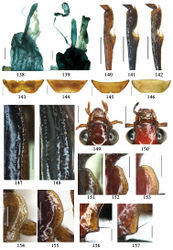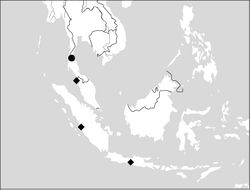Metallanchista
| Notice: | This page is derived from the original publication listed below, whose author(s) should always be credited. Further contributors may edit and improve the content of this page and, consequently, need to be credited as well (see page history). Any assessment of factual correctness requires a careful review of the original article as well as of subsequent contributions.
If you are uncertain whether your planned contribution is correct or not, we suggest that you use the associated discussion page instead of editing the page directly. This page should be cited as follows (rationale):
Citation formats to copy and paste
BibTeX: @article{Shi2013ZooKeys284, RIS/ Endnote: TY - JOUR Wikipedia/ Citizendium: <ref name="Shi2013ZooKeys284">{{Citation See also the citation download page at the journal. |
Ordo: Coleoptera
Familia: Carabidae
Name
Metallanchista Shi & Liang gen. n. – Wikispecies link – ZooBank link – Pensoft Profile
Type-species:
Metallanchista laticollis Shi & Liang, sp. n.
Diagnosis
Surface glabrous, with distinct metallic reflection; mandibles moderately widened (Fig. 149); umbilical pores of 9th interval placed in two rows (Fig. 148); males with terminal sternum deeply emarginate, bisetose on each side; males without adhesive hairs on metatarsomeres; median lobe of aedeagus without setae around apical orifice; internal sac with main flagellum reduced. These characters readily distinguish the new genus from all other genera of Physoderina.
The gen. n. is most closely allied to Anchista, but can be distinguished by: (1) median lobe with apical lamella longer and bent dorsally; (2) males with two pairs of setae on terminal sternum; (3) umbilical pores of 9th interval placed in two rows. Metallanchista new genus also resembles some species of Physodera, but differs by the following characters: (1) pronotum with mid-lateral setae; (2) basal margination of elytra nearly complete; (3) elytral intervals more or less convex; (4) 3rd to 5th intervals slightly depressed at basal two-fifths; (5) mandibles moderately widened.
Generic characters
Body rather flat, dorsal side with distinct metallic reflections; microsculpture indistinct. Head glabrous; eyes hemispherical, prominent; tempora short, nearly half as long as eyes, abruptly narrowed behind eyes; vertex flat. Antennae hardly extended to elytral base; 1st antennomere stout, slightly expanded in middle, slightly narrowed to base, 3rd as long as 4th. Labrum smooth, without any secondary setae; mandibles moderately widened, outer margin nearly straight, glabrous on outer scrobe and dorsal ridge; terminal maxillary palpomeres fusiform in both sexes; terminal labial palpomeres moderately expanded but not strongly securiform in both sexes; ligula with apex nearly truncate, with four long setae; paraglossae membranous, slightly longer than ligula, adnate; mentum tooth wide and rounded, with two long setae near base, a few additional short setae present on central area of mentum; submentum with four long setae, distant from lateral margin; genae and gula with a few short seta at anterior part. Pronotum wider than head, disc glabrous; mid-lateral setae present; front angles more or less setose, hind angles generally with a few additional short setae; pronotal base briefly but distinctly lobed; lateral margins rounded or slightly angulate, strongly sinuate before hind angles; hind angles sharp. Elytra wide, apex truncate, sutural angles not projected, outer angles completely rounded; lateral margins slightly depressed in basal one-third, disc with an indistinct depression near basal two-fifths; intervals glabrous, without additional setae; umbilical pores of 9th interval placed in two rows (Fig. 148), the outer row (the primary umbilical pore series) adjacent to lateral expansion usually composed of 18 pores, the inner row (secondary umbilical pore series) adjacent to 8th stria usually composed of 10 pores; basal margination nearly complete; basal pores well developed; 3rd interval with two setigerous pores, basal one located at basal one-third approximately, adjacent to 3rd stria, apical one at apical one-eighth approximately, adjacent to 2nd stria; 5th interval slightly widened at base, with one setigerous pore near base, adjacent to 5th stria; 7th and 8th intervals slightly tumid near apex. Ventral side nearly glabrous; males with terminal sternum deeply emarginate apically (Fig. 143), bisetose on each side; females with terminal sternum straight apically, bisetose on each side. Legs short; protibiae with cleaning spur well developed, distant from inner margin; tarsi widened, 4th tarsomere bifid, claws pectinate; males with adhesive hairs well developed (two whole rows) on 1st to 3rd pro-, and 2nd to 3rd mesotarsomeres, rudimentary (two rows weakly present near apex) on 1st mesotarsomere. Male genitalia with median lobe of aedeagus not twisted; apical orifice opened dorsally, apical lamella without long setae; apical lamella strongly bent dorsally; internal sac with main flagellum fully reduced, without any distinct sclerite, some parts of internal sac strongly scaled. Female genitalia. Apical segment of ovipositor straight, glabrous; membranous extension short, slightly sclerotized. Internal reproductive system not studied.
Distribution
(Map 4). Malay Peninsula, Sumatra, Java.
Etymology
The genus name “Metallanchista” is combined from the Greek “metall”, a reference to metal, and the genus name “Anchista”, meaning that it is closely related to genus Anchista, but strongly metallic. The gender of this genus name is feminine.
Monophyly and relationships
The new genus is most closely allied with Anchista, as both genera have the main flagella of the aedeagal median lobe fully reduced. Both are also allied with Paraphaea and Endynomena in sharing: (1) median lobe of aedeagus usually strongly setose around apical orifice; (2) mandibles usually moderately widened; (3) basal margination of elytra usually complete. These character states may be synapomorphies for this lineage in the subtribe.
We establish this new genus based on the following apomorphic character states: (1) umbilical pores of 9th interval placed in two rows; (2) median lobe of aedeagus with apex strongly bent dorsally, internal sac without distinct sclerite, but scaled in certain areas; (3) submentum quadrisetose, ventral side of head with some accessory setae; (4) terminal sternum of males with two pairs of setae on each side.
Taxonomic comments
So far as we know, there is no other genus of Lebiini with two rows of umbilical pores as in Metallanchista gen. n. The pore series in Metallanchista gen. n. contains more pores than in other allied genera, 28 pores contrasting with usually 15–20 pores in other genera. So the peculiar pore series is not the result of a different arrangement, but due to the presence of the unique secondary pore series adjacent to the 8th stria. The outer pore series, composed of 18 pores adjacent to the lateral expansion, is the primary pore series and homologous with the umbilical pore series in other genera.
Key to species of Metallanchista gen. n
Original Description
- Shi, H; Zhou, H; Liang, H; 2013: Taxonomic synopsis of the subtribe Physoderina (Coleoptera, Carabidae, Lebiini), with species revisions of eight genera ZooKeys, 284: 1-129. doi
Images
|

